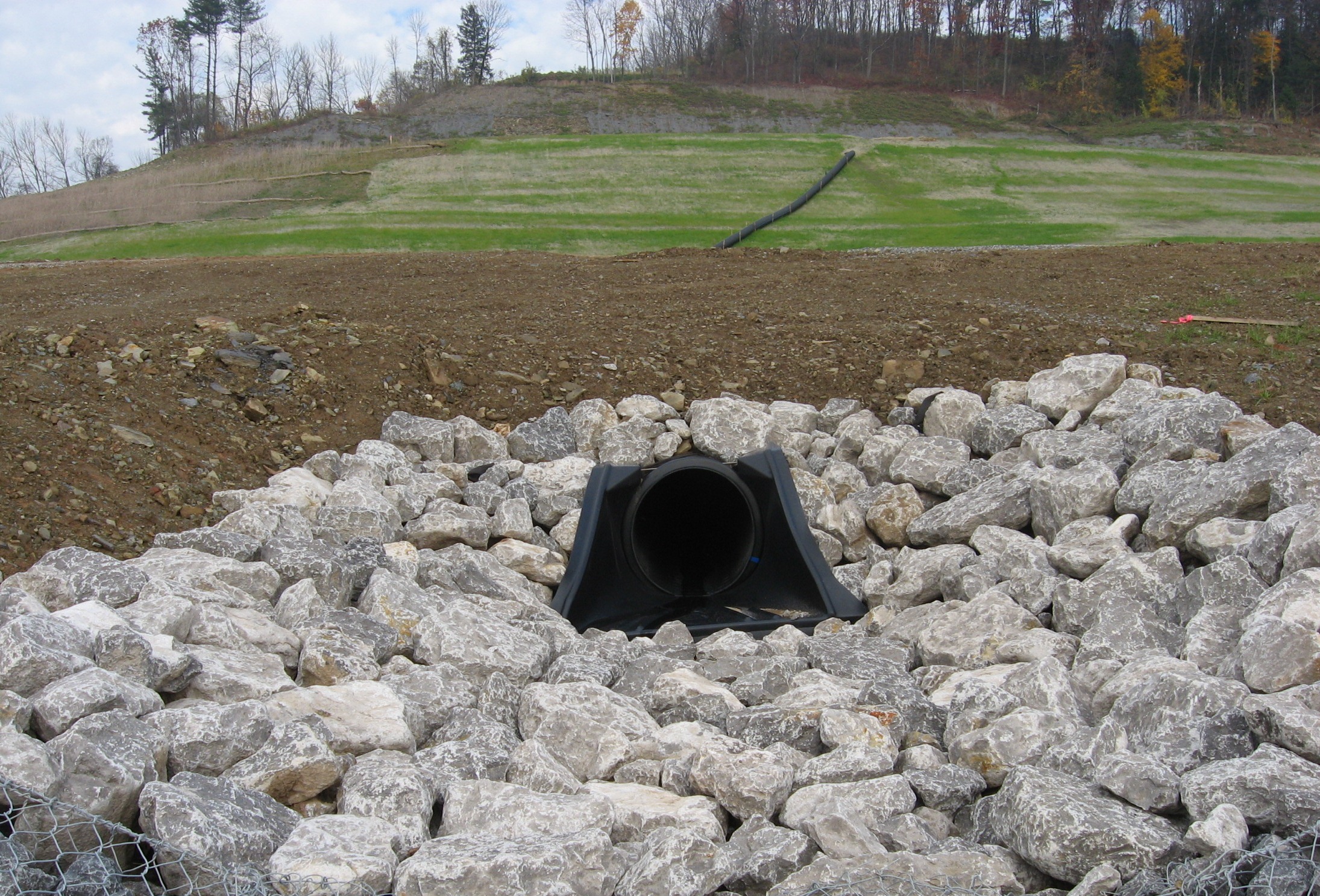Outlet Protection and Stabilization

Definition
A structure designed to control erosion at the outlet of a channel or conduit by reducing the velocity of flow and dissipating the energy.
Where Practice Applies
- Outlet protection should be installed at all pipe, culverts, swales, diversions, or other water conveyances where the velocity of flow may cause erosion at the pipe outlet and in the receiving channel.
- Outlet protection should be installed early during construction activities, but may be added at any time, as necessary.
Advantages
- A planned (designed) plunge pool can be an effective energy dissipation device.
- Plunge pools, which can develop unless outlet protection is provided, may severely weaken the embankment and thus threaten its stability.
- Protection can prevent scouring at a culvert mouth and thus prevent gully erosion which may gradually extend upstream.
Disadvantages/Problems
- Some types of structures may be unsightly.
- Sediment removal may be diffcult.
Planning Considerations
- Erosion at the outlet of channels, culverts, and other structures is common and can cause structural failure with serious downstream problems.
- A riprap-lined apron is the most commonly used structure for this purpose, because it has relatively low cost and can be installed easily on most sites.
- Other types of outlet stabilization structures include riprap stilling basins, concrete impact basins, and paved outlets.
Design Criteria
- Capacity - Peak runoff from 10-year storm.
- Apron - As shown in plans, set on zero grade, aligned straight, with suffcient length to dissipate energy.
- Foundation - Extra-strength filter fabric or well-graded gravel filter layer, 6 inches thick, minimum.
Installation
- Excavate subgrade below design elevation to allow for thickness of filter and riprap. Install riprap to minimum thickness of 1.5 times maximum stone diameter. Final structure should be to lines and elevations shown in plans.
- Construct apron on zero grade. If there is no well-defined channel, cross section may be level or slightly depressed in the middle. In a well-defined channel, extend riprap and filter to the top of the bank or as shown on plans. Blend riprap smoothly to the surrounding land.
- Apron should be straight and properly aligned with the receiving stream. If a curve is necessary to fit site conditions, curve the apron near the upstream end.
- Compact any fill used in the subgrade to the density of the surrounding undis- turbed material.
- Subgrade should be smooth enough to protect fabric from tearing.
- Install a continuous section of extra-strength filter fabric on smooth, compacted foundation.
- Protect filter fabric from tearing while placing riprap with machinery. Repair any damage immediately by removing riprap and installing another section of filter fabric. Upstream section of fabric should overlap downstream section a minimum of one foot.
- Make sure top of riprap apron is level with receiving stream or slightly below it. Riprap should not restrict the channel or produce an overfall.
- Immediately following installation, stabilize all disturbed areas with vegetation as shown in plans.
Common Trouble Points
- Foundation not excavated deep enough or wide enough: Riprap restricts flow cross section, resulting in erosion around apron and scour holes at outlet.
- Riprap apron not on zero grade: Causes erosion downstream.
- Stones too small or not properly graded: Results in movement of stone and down- stream erosion.
- Riprap not extended far enough to reach a stable section of channel: Results in downstream erosion.
- Appropriate filter not installed under riprap: Results in stone displacement and erosion of foundation.
Maintenance
- Inspect riprap outlet structures after heavy rains for erosion at sides and ends of apron and for stone displacement.
- Rock may need to be added if sediment builds up in the pore spaces of the outlet pad.
- Make repairs immediately using appropriate stone sizes. Do not place stones above finished grade.
References
Massachusetts Department of Environmental Protection, Offce of Watershed Management, Nonpoint Source Program, Massachusetts Nonpoint Source Management Manual Boston, Massachusetts, June, 1993.
North Carolina Department of Environment, Health, and Natural Resources, Erosion and Sediment Control Field Manual, Raleigh, NC, February 1991.
U. S. Environmental Protection Agency, Storm Water Management for Construction Activities, EPA-832-R-92-005, Washington, DC, September, 1992.
Washington State Department of Ecology, Stormwater Management Manual for the Puget Sound Basin, Olympia, WA, February, 1992